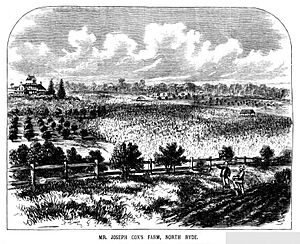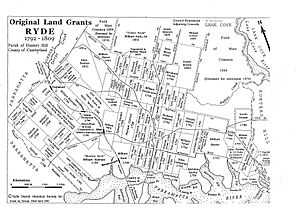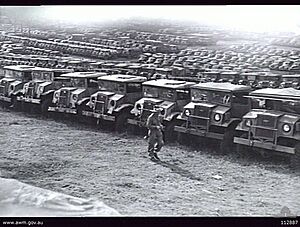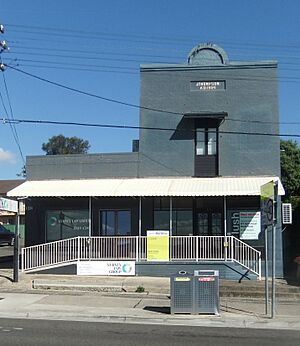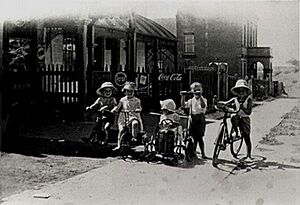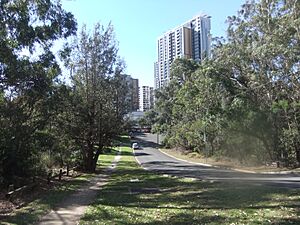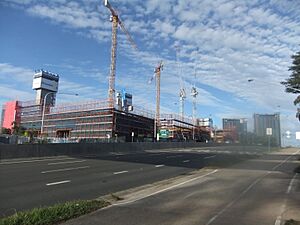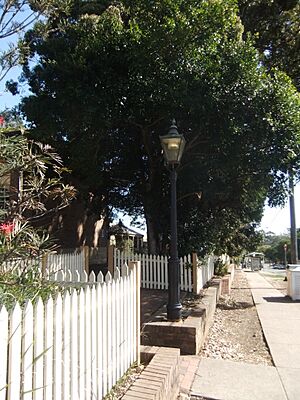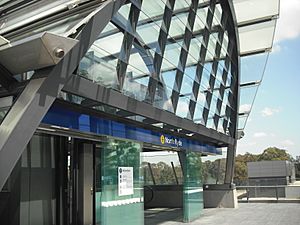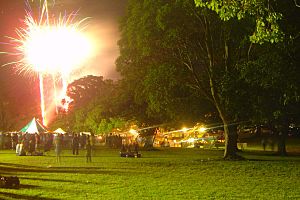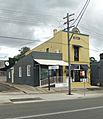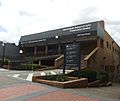North Ryde, New South Wales facts for kids
Quick facts for kids North RydeSydney, New South Wales |
|||||||||||||||
|---|---|---|---|---|---|---|---|---|---|---|---|---|---|---|---|
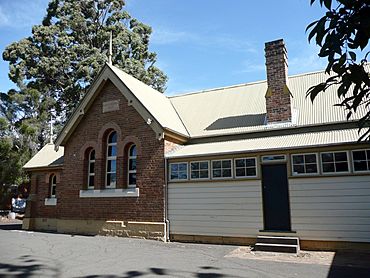
North Ryde Public School, established in 1877
|
|||||||||||||||
| Population | 10,860 (2016 census) | ||||||||||||||
| • Density | 2,026.1/km2 (5,248/sq mi) | ||||||||||||||
| Postcode(s) | 2113 | ||||||||||||||
| Elevation | 57 m (187 ft) | ||||||||||||||
| Area | 5.36 km2 (2.1 sq mi) | ||||||||||||||
| Location | 15 km (9 mi) NW of Sydney CBD | ||||||||||||||
| LGA(s) | City of Ryde | ||||||||||||||
| State electorate(s) | Ryde, Lane Cove | ||||||||||||||
| Federal Division(s) | Bennelong | ||||||||||||||
|
|||||||||||||||
North Ryde is a busy suburb in Sydney, New South Wales, Australia. It's about 15 kilometres north-west of the main city centre. North Ryde is part of the City of Ryde area.
This suburb is a major business hub in Australia. Many big international companies like Microsoft, Hewlett-Packard, and Oracle have offices here. It's also home to Macquarie University, so many people who live here work at the university or in research. The Commonwealth Scientific and Industrial Research Organisation (CSIRO), which is Australia's national science agency, also has a large office in North Ryde.
North Ryde shares its postcode (2113) with nearby suburbs like Macquarie Park and East Ryde. These areas used to be part of North Ryde. Even today, some businesses and homes in those suburbs still use "North Ryde" in their address. Macquarie University, which is next door, got its own special postcode (2109) in the late 1980s.
Contents
- Discovering North Ryde's Past
- Cox's Road: The Heart of North Ryde
- The "Never Was" Electricity Substation
- Who Lives in North Ryde?
- Shopping and Business Areas
- Future Plans for North Ryde Station
- Schools in North Ryde
- Hospitals in North Ryde
- Cemeteries and Crematoria
- Getting Around North Ryde
- Parks and Green Spaces
- Sports and Fun Activities
- Gallery
Discovering North Ryde's Past
The name "North Ryde" first appeared around 1879. This was when the local public school, which opened in 1878, changed its name from City View Public School to North Ryde Public School. Before that, North Ryde was mostly farmland. The suburb is an extension of Ryde, which was named after a store run by G.M. Pope. He got the name from his hometown of Ryde on the Isle of Wight in the UK.
Original Inhabitants: Aboriginal Culture
The land between the Parramatta and Lane Cove Rivers was originally home to Indigenous Australians. They called this area Wallumatta. Sadly, when the first European settlers arrived, many Aboriginal people died from diseases like smallpox. The name Wallumatta lives on in the Wallumatta Nature Reserve. This special reserve is one of the last remaining parts of the Sydney Turpentine-Ironbark Forest. This type of forest is very rare and is considered endangered in Sydney.
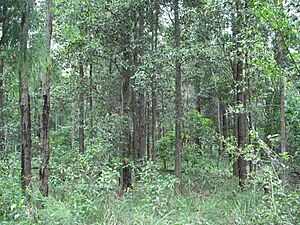
European Settlers Arrive
Ryde is one of Australia's oldest settlements, after Sydney and Parramatta. The area was first called "Eastern Farms" in 1792. North Ryde started as a farming area in the mid-1800s. It was a heavily forested place next to the already settled Ryde district. The Field of Mars Common, a large open area, was known to be a bit dangerous because escaped convicts and bushrangers sometimes hid there.
Early Farming Families
One of the first settlers to get land in what is now North Ryde was Jane Wood in 1800. Other early settlers included David Brown, William Kent Jnr, James Weavers, Michael Connor, and Thomas Granger.
James Weavers, a farm worker, arrived in Australia in 1790 as a convict. He was given 30 acres of land in what is now Putney. He became a successful farmer and bought more land. Sadly, he is thought to have been killed by Aboriginal people in 1805. Many early farming families in the area, like the Weavers, Wicks, Benson, Cox, Hicks, and Heard families, were connected through marriages.
Henry Heard came from England and started an orchard on Twin Road. He and his wife Mary Jane had nine children. He bought more land and expanded his orchards and vineyards. His farm was called the Model Farm. Two of his old cottages, built in the late 1800s, are still standing today.
Around 1868, Joseph Cox and his brother William bought land in North Ryde. Joseph and his wife named their farm "Pomona." They grew many fruits and grapes, and Joseph was a skilled winemaker. Around 1880, Joseph built a large three-story house from local stone. It had a great view of Sydney from its upstairs balcony.
George Wicks was the Mayor of Ryde in 1876. He and his wife had 12 children. Henry William Watts, another descendant of James Weavers, was also a Mayor of Ryde. These families were orchardists who worked hard to get a local school built in North Ryde.
Motorcycling Fun
In 1928, the Chatswood Motorcycle Club built a race track in the area. It was an early type of off-road speedway. The first races attracted thousands of spectators! This track later moved to what is now part of the North Ryde Golf Course. It was a natural bowl shape, so everyone had a great view. The track closed around 1935 when the golf course was developed. A famous rider named Ray "Broadside" Taylor started his career here. He later became an Australian and international speedway star.
North Ryde During World War II
During World War II, a large army base was set up in North Ryde. It was called the 3rd Australian Ordnance Army Vehicle Park. Many military vehicles like Jeeps, tanks, and trucks were stored there. There were also workshops and barracks for soldiers.
After the War: A Changing Landscape
North Ryde stayed mostly rural until after World War II. Most people were farmers, growing fruits, vegetables, and raising poultry. In the 1950s and 1960s, the government bought much of the land. They divided it up to build homes for war veterans and public housing. This changed North Ryde from a farming area to a suburban neighbourhood. Many old buildings were taken down to make way for new developments.
After the war, the army huts were used as homes for new immigrants and Australian families who needed housing. There was also a large pig farm on Wicks Road until the late 1960s. An outdoor movie theatre, known as "the Shack," operated on Khartoum Road for many years.
In 1956, the North Ryde Skyline Drive-In Theatre opened. It could hold 639 cars and had a restaurant and a playground. It closed in 1986.
Cox's Road: The Heart of North Ryde
Cox's Road is the main street in North Ryde. It was originally paved with sandstone to make it easier to move goods from the Lane Cove River wharf up the hill. The road is named after Joseph Cox, an early landowner. The North Ryde Post Office, which opened in 1885, moved to Cox's Road in 1908 and has moved several times within the shopping area since then.
The North Ryde School of Arts and Literary Institute was built in 1901. It was a place for community events like dances, art shows, and meetings. The local library branch was also located here. The original building was replaced by a new Community Centre, School of Arts, and Library complex in 1980.
Thompson's Shop, built in 1904, was the general store and post office for many years. It's one of the few original buildings left from those early days, along with the old schoolhouse and some heritage cottages. Three gas street lamps were installed on Cox's Road in the 1920s. One has been restored and stands in front of the schoolhouse. The Cox's Road Shopping Centre was rebuilt after a fire around 1990.
The "Never Was" Electricity Substation
The S.M.C. (Sydney Municipal Council) Electric Lighting Substation No. 79 was finished in 1916. It was meant to supply electricity to the Ryde area. However, it was never used for this purpose and became known as "the electricity substation that never was." It's now a heritage-listed building, and new townhouses have been built behind it. The original sign is still on the front.
Who Lives in North Ryde?
In 2016, there were 10,860 people living in North Ryde. About 57% of them were born in Australia. Other common birthplaces included China (7.2%), India (2.7%), and England (2.3%). Most people (57.4%) spoke only English at home. Other languages spoken included Mandarin (8.1%), Cantonese (5.1%), and Armenian (4.4%). The most common religions were Catholic (27.8%), no religion (25.4%), and Anglican (11.5%).
Shopping and Business Areas
North Ryde has many shops and businesses. The Cox's Road Shopping Centre has a supermarket, the post office, and other specialty shops. The Public School, Community Centre, Library, and School of Arts are all nearby. There are also cafes and eateries across the road. Other shops can be found on Blenheim Road and Avon Road.
In 1961, the CSIRO (Australia's science agency) moved its food preservation division to North Ryde. The mid-1960s saw the creation of the North Ryde Industrial Area and Macquarie University. This was inspired by the successful industrial areas around Stanford University in California. The businesses here were meant to be "light" and science-related. Since then, the area has grown a lot. The business parks in Macquarie Park and Riverside Corporate Park are now known as leading high-tech areas in Australia. They attract major companies in information technology, communication, electronics, and medicine.
Network Ten, a TV channel, had its main offices and studios in North Ryde from 1965 to 1991. The site is now home to the North Ryde railway station and apartment buildings.
Future Plans for North Ryde Station
The North Ryde Station Precinct Concept Plan is a project to decide what the area around North Ryde railway station will look like in the future. In 2013, plans were approved for new developments. Construction began in 2015, and apartment towers called Ryde Gardens are now occupied. Another set of towers, Lachlan's Line, is also being built. A bridge for walking and cycling will connect these new buildings directly to the North Ryde Railway Station.
Schools in North Ryde
North Ryde's first public school, City View Public School, opened in 1878. It changed its name to North Ryde Public School in 1879. It was called "City View" because you could see Sydney from its roof! The original building on Cox's Road, built in 1877, is now the New South Wales Schoolhouse Museum of Public Education. It's one of the oldest school buildings in the state.
A second primary school, Truscott Street Public School, opened in 1958 for children of World War II veterans. In 1988, this school added a "Special Unit" for children with special needs.
North Ryde High School opened in 1962. It was later renamed Peter Board High School. Many locals felt this name change took away its local identity. The high school closed in 1998, leaving North Ryde without a local high school. The closest option is now Ryde Secondary College.
Holy Spirit Primary School, a Catholic school, is also on Cox's Road. Ryde East Primary School is on Twin Road and has about 350 students. Arndell School is located on the Macquarie Hospital campus.
Hospitals in North Ryde
Macquarie Hospital
Macquarie Hospital is a specialist mental health facility. It opened in 1959 and was first known as the North Ryde Mental Asylum. It has changed names several times and is now called Macquarie Hospital. It helps adults with mental health conditions in the Northern Sydney and Central Coast areas. The hospital works with community mental health groups. There are no emergency services at Macquarie Hospital.
Macquarie University Hospital
The Macquarie University Hospital is a private hospital that opened in 2010. It's located on the Macquarie University campus. This hospital is a main teaching hospital for the University's medical school. It has some of the most advanced medical equipment in Australia, including the first gamma knife in the country. Like Macquarie Hospital, it does not have emergency services.
Cemeteries and Crematoria
Field of Mars Cemetery
The Field of Mars Cemetery is one of Sydney's oldest cemeteries. It opened in 1890 and is located on Quarry Road. About 66,000 people are buried there.
Macquarie Park Cemetery and Crematorium
The Macquarie Park Cemetery and Crematorium opened in 1922. It used to be called the Northern Suburbs General Cemetery. It covers a large area of land on Delhi Road, right across from the North Ryde underground metro station.
Northern Suburbs Crematorium
This crematorium, now called the Northern Suburbs Memorial Gardens and Crematorium, opened in 1933. It's the second oldest crematorium in Sydney, after Rookwood. It's located on Delhi Road.
Getting Around North Ryde
The M2 Hills Motorway goes through North Ryde, connecting to other major roads that lead to the Sydney central business district. Lane Cove Road (A3) runs through North Ryde from north to south, linking Sydney's North Shore to Sydney Olympic Park. Epping Road goes from west to east, crossing the Lane Cove River Bridge.
North Ryde has many public buses that travel throughout the area. There are also private shuttle buses for local trips and airport services.
North Ryde railway station is an underground train station that opened in 2009. It's near the intersection of Epping Road and Delhi Road. The station closed for seven months in 2018 to become a Sydney Metro station. It reopened in May 2019 with automated, driverless trains. The area that was once known as North Ryde now has three underground train stations: North Ryde, Macquarie Park, and Macquarie University. A major transport hub is planned for Macquarie.
Parks and Green Spaces
North Ryde has many beautiful parks and reserves. These include North Ryde Common, the nearby Lane Cove National Park, and the Field of Mars Reserve. You can also access the Great North Walk and the Lane Cove River. The river was once home to the famous Fairyland picnic grounds, where people would come by boat from Sydney for dances. Today, very little remains of Fairyland.
North Ryde Park was upgraded in 2009 with new facilities and a children's play area. Blenheim Park is a family park with an off-leash area for dogs. The Lane Cove River Tourist Park is a caravan park located in the Lane Cove National Park, close to the North Ryde train station.
Sports and Fun Activities
- Macquarie University Theatre offers classical concerts and other performances.
- North Ryde Golf Club has an 18-hole golf course, dining, and event facilities. It used to be a motorcycle racing track!
- North Ryde RSL Community Club has restaurants, live entertainment, and various sports clubs.
- Australia Day concerts and Carols by Candlelight are held each year at North Ryde Common.
- Ryde Hunters Hill Hockey Club offers field hockey for juniors, women, and men.
- North Ryde Junior Rugby League Football Club (The Hawks) has been around for over 50 years.
Gallery
-
entrance to Wallumatta Nature Reserve
-
Group of four tawny frogmouths


